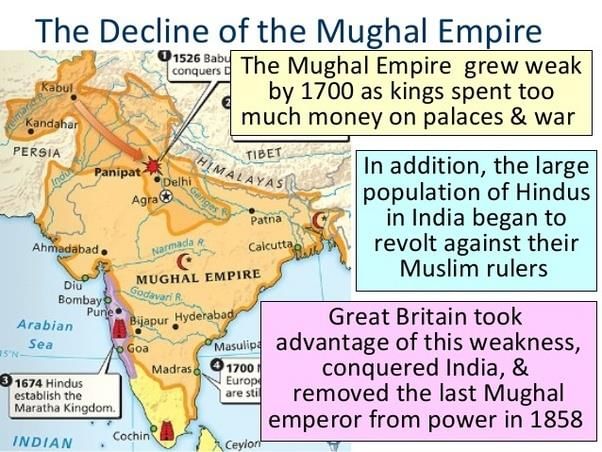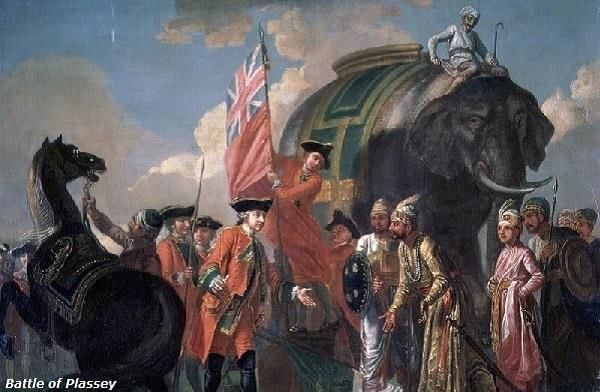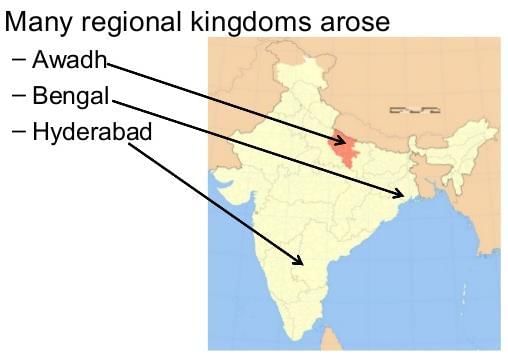Spectrum Summary: India on the Eve of British Conquest | History for UPSC CSE PDF Download
| Table of contents |

|
| Challenges before the Mughals |

|
| Causes of Decline of the Mughal Empire |

|
| Major Factors Which Contributed to Downfall |

|
| Rise of Regional States |

|
| Socio-Economic Conditions |

|
Do you know when Indian rulers lost a battle against the East India Company, they used to pay the compensation amount in lakhs in the 1700s to the company? Imagine the wealth our country had during that time , which was eventually looted by the British. In this EduRev document, you will read about the conditions that prevailed when the Company entered India and how the great Mughal empire came to decline and how weak was the administration during that period.

- In the first half of the eighteenth century, the once-mighty Mughal Empire, which had been the envy of its contemporaries for nearly two centuries, experienced a significant decline.
- The reign of Aurangzeb (1658-1707) is often cited as the starting point of this decline. His policies, considered by many as misguided, weakened the stability of the state. After Aurangzeb's death, the decline gained momentum due to wars of succession and the rule of weak monarchs.
- Muhammad Shah, who ruled for a lengthy period of 29 years (1719-1748), was unable to revive the imperial fortunes. His incompetence as a ruler further contributed to the challenges faced by the Mughal Empire during this period.
Challenges before the Mughals
External Challenges
The northwestern borders had been neglected by the later Mughals and little effort was made in protecting the border.

Nadir Shah's Invasion (1738-39):
- Persian emperor Nadir Shah (or Nader Shah) attacked India.
- He conquered Lahore and defeated the Mughal army at Karnal on February 13, 1739.
- Muhammad Shah was captured, and Delhi was looted and devastated.
- Peacock Throne and the Kohinoor diamond were among the treasures taken.
- Approximately seventy crore rupees were collected from the official treasury and rich nobles' safes.
Ahmad Shah Abdali's Invasions (1748-1767):
- Ahmad Shah Abdali, the elected successor of Nadir Shah, invaded India multiple times.
- The Mughals attempted to buy peace in 1751-52 by ceding Punjab to Abdali.
- In 1757, Abdali captured Delhi, leaving an Afghan caretaker to oversee the Mughal emperor.
- Abdali acknowledged Alamgir II as the Mughal emperor and appointed Najib-ud-Daula as Mir Bakhshi.
- Najib-ud-Daula acted as the personal 'supreme agent’ of Abdali.
- In 1761, Abdali defeated the Marathas in the Third Battle of Panipat.
- Abdali's last invasion occurred in 1767.
Why Many Empire-shaking Battles at Panipat?
- Panipat and the nearby area, now in Haryana, are located on the banks of the Yamuna River and lie between the fertile plains of the Ganga and Indus rivers. This region has seen many battles that have significantly influenced the history of India.
- The First Battle of Panipat occurred in 1526 between Babur and Ibrahim Lodi. This battle marked the beginning of the Mughal Empire by ending the rule of the Delhi Sultanate.
- The Second Battle of Panipat took place in 1556 between Akbar and Hemu; its outcome favored the continuation of Mughal rule.
- The Third Battle of Panipat occurred in 1761 between the Marathas and Ahmad Shah Abdali, which ended the Maratha ambition to dominate India.
Reasons Why Panipat Was a Popular Battlefield
- Panipat’s strategic location made it a preferred site for battles. One side usually arrived from the north or north-west via the Khyber Pass to gain control of Delhi, the political centre of northern India. Moving an army through challenging terrains, like the Rajasthan deserts or the dense forests of the north, was risky. Therefore, rulers in Delhi viewed Panipat as a favorable battleground.
- Being close to Delhi allowed Indian rulers to easily transport weapons, troops, and food supplies to the battlefield while keeping the capital safe from direct conflict.
- The flat terrain around Panipat was ideal for cavalry movements, which were the main form of warfare at that time.
- After Sher Shah Suri built the Grand Trunk Road between 1540 and 1545, Panipat became a key stop on this route, making it easier for conquerors to reach the area.
- The monsoon season in this region is relatively short compared to other places, making it easier to conduct battles.
- The local artisans and smiths were skilled in producing materials for warfare, allowing both sides to quickly restock their resources during conflicts.
Weak Rulers after Aurangzeb—An Internal Challenge
The Mughal Empire faced significant challenges after the reign of Aurangzeb, particularly due to weak leadership and internal strife. The emperors who followed Aurangzeb struggled to maintain control and authority over the vast empire.
Bahadur Shah I (1709-March 1712):
- After a nearly two-year-long war of succession, the 63-year-old Prince Muazzam, the eldest son of Aurangzeb, became the emperor, taking the title Bahadur Shah. (He was later called Bahadur Shah I.)
- He adopted a peaceful policy with the Marathas, the Rajputs, and the Jats.
- The Sikh leader Banda Bahadur attacked Muslims in Punjab, and Bahadur Shah I took action against him.
- Bahadur Shah I died in February 1712.
Jahandar Shah (March 1712-February 1713):
- With the help of Zulfikar Khan, Jahandar Shah became the emperor, and Zulfikar Khan was appointed prime minister.
- Jahandar Shah abolished Jizya tax.
Farrukhsiyar (1713-1719):
- After killing Jahandar Shah with the help of Sayyid brothers—Abdulla Khan and Hussain Ali (known as the King Makers), Farrukhsiyar became the new emperor.
- He followed a policy of religious tolerance by abolishing Jaziya and the pilgrimage tax.
- In 1717 AD, Farrukhsiyar issued a farman to the British granting them the right to reside and trade in Bengal.
Rafi-ud-Darajat (February 28 to June 4, 1719):
- He ruled for the shortest period in Mughal history.
Rafi-ud-Daula (June 6 to September 17, 1719):
- The Sayyid brothers placed Rafi-ud-Daula with the title Shah Jahan II on the throne. The new emperor was an opium addict.
Muhammad Shah (1719-48):
- In 1724, Nizam-ul-Mulk became the wazir and founded the independent state of Hyderabad.
- In 1739, Nadir Shah defeated the Mughals in the Battle of Karnal.
Ahmad Shah (1748-1754):
- Udham Bai, the 'Queen Mother,' was given the title of Qibla-i-Alam.
Alamgir II (1754-1758):
- Ahmed Shah Abdali, the Iranian invader, reached Delhi in January 1757.
- During his reign, the Battle of Plassey was fought in June 1757.

Shah Jahan III (ruled 1759–60)
- Muhiul-millat is another name for him.
- He became king due to political schemes in Delhi.
- Later, he was removed from power with the help of the Marathas.
Shah Alam II (ruled Oct. 1760–July 1788; Oct. 1788–Nov. 1806)
- His reign saw two decisive battles—the Third Battle of Panipat (1761) and the Battle of Buxar (1764).
- In the Treaty of Allahabad (August 1765), he was taken under the East India Company’s protection and resided at Allahabad.
- He issued a Farman granting the Company in perpetuity the Diwani (the right to collect revenue) of Bengal, Bihar, and Orissa.
Akbar II (1806-37):
- He gave the title of Raja to Ram Mohan Rai.
- In 1835, the coins bearing the names of Mughal emperors were stopped.
Bahadur Shah II (1837-1857):
- Bahadur Shah Zafar, the last Mughal emperor.
- Captured by the English and sent to Rangoon, where he died in 1862.
- The Mughal Empire came to an end on November 1, 1858, with the declaration of Queen Victoria.
Causes of Decline of the Mughal Empire
- Mughal Perspective: Empire-related or Mughal-centric view sees the causes of the decline within the structure and functioning of the empire itself.
- Regional Perspective: Region-related view finds the causes of the Mughal decline in the turmoil and instability in the different parts of the empire.
- Successors of Aurangzeb: Emperors who came after Aurangzeb proved to be incapable, weak and licentious monarchs who hastened the process of disintegration of the empire and, finally, its collapse.
Major Factors Which Contributed to Downfall
Shifting Allegiance of Zamindars- The zamindars were hereditary owners of their lands who enjoyed certain privileges on a hereditary basis and were variously known as rais, rajas, Thakur, khuts or Deshmukh.
- They helped in the collection of revenue and local administration and increased during Aurangzeb's reign.
Jagirdari Crisis
- Mughal rule has often been defined as “the rule of the nobility”.
- Divisiveness among the nobility based on religion, homeland and tribe.
- Mutual rivalry, jealousy and contest for power among the various groups during the rule of the later Mughals and the absence of strong central leadership) contributed to the decline of the empire.
Rise of Regional Aspirations
- The Rajput struggle against the empire and the growing ambition and power of the Marathas, thus, adversely affected the Mughals.
Economic and Administrative Problems
- The expenditure of the state much exceeded its income.
Rise of Regional States
- Successor States- The Mughal provinces that turned into states after breaking away from the empire. Awadh, Bengal and Hyderabad.

- Independent Kingdoms- These states came into existence primarily due to the destabilisation of the Mughal control over the provinces that is Mysore, Kerala and the Rajput states.
- The New States - These were the states set up by the rebels against the Mughal empire, Maratha, the Sikh and the Jat states.
Survey of Regional Kingdoms
Hyderabad
- The founder of the Asaf-Jah house of Hyderabad was Kilich Khan, popularly known as Nizam-ul-Mulk.
- The idea of an independent state in the Deccan is by Zulfikar Khan.
- He killed Mubariz Khan in the Battle of Shakr-Kheda (1724). full-fledged viceroy of the Deccan.
- In 1725, he became the viceroy and conferred on himself the title of Asaf-Jah.
Awadh
- The founder of the independent principality of Awadh was Saadat Khan, popularly known as Burhan-ul-Mulk.
- Safdar Jang succeeded him as the Nawab of Awadh.
Bengal
- Murshid Kuli Khan was the founder of the independent state of Bengal.
- Succeeded in 1727 by his son Shujaud-din. His successor, Sarfaraz Khan, was killed in 1740 by Alivardi Khan, the deputy governor of Bihar in Gheria.
The Rajputs
- The Rajputs tried to re-establish their independence in the 18th century. This forced the Mughal ruler Bahadur Shah I to march against Ajit Singh (1708), who had allied with Jai Singh II and Durgadas Rathor. But the alliance was broken and the situation was saved for the Mughals. At one time the Rajputs controlled the entire territory extending from the south of Delhi up to the western coast.
Mysore
- This territory located at the junction of the Eastern and Western Ghats was ruled by the Wodeyars.
- The state of Mysore was brought under the rule of Haider Ali.
Kerala
- Martanda Varma established an independent state of Kerala with Travancore as his capital. He extended the boundaries of his state from Kanyakumari to Cochin.
The Jats
- Churaman and Badan Singh succeeded in setting up the Jat state of Bharatpur. But it was under Suraj Mal that Jat's power reached its zenith.
- The state included territories from Ganga in the east to Chambal in the south and included the Subahs of Agra, Mathura, Meerut and Aligarh.
- The Jat state suffered a decline after the death of Suraj Mai in 1763.
The Sikhs
- Guru Gobind Singh transformed the Sikhs into a militant sect in defence of their religion and liberties.
- Banda Bahadur later assumed the leadership of the Sikhs in 1708.
- 12 misls or confederacies which exercised control over different parts of the kingdom.
- The credit for establishing a strong kingdom of Punjab goes to Ranjit Singh. He was the son of Mahan Singh, the leader of the Sukarchakiya misl. Ranjit Singh brought under control the area extending from the Sutlej to the Jhelum. He conquered Lahore in 1799 and Amritsar in 1802.
- In The Treaty of Amritsar with the British, Ranjit Singh acknowledged the British right over the cis-Sutlej territories.
- The Tripartite Treaty in 1838 with Shah Shuja and the English Company whereby he agreed to provide passage to the British troops through Punjab to place Shah Shuja on the throne of Kabul. Ranjit Singh died in 1839.
The Marathas
- Under the capable leadership of the Peshwas, the Marathas uprooted the Mughal authority from Malwa and Gujarat and established their rule.
- Ahmed Shah Abdali challenged their authority in the Third Battle of Panipat (1761).
Rohilakhand and Farukhabad
- The states of Rohilakhand and the kingdom of the Bangash Pathans were a fallout of the Afghan migration into India.
- Ali Muhammad Khan set up the petty kingdom, Rohilakhand.
- This was the area of the Himalayan foothills between Kumaon in the north and the Ganga in the south.
- Mohammad Khan Bangash, an Afghan, set up an independent kingdom to the east of Delhi in the area around Farrukhabad.
Nature and Limitations of Regional States
- The new political system was regional and collaborated with various local groups, such as zamindars, merchants, local nobles, and chieftains.
- The provincial rulers failed to develop a system based on sound financial, administrative and military organisation.
- The jagirdari crisis intensified as income from agriculture declined, and the number of contenders for a share of the surplus multiplied.
Socio-Economic Conditions
- Agriculture- Though agriculture was technically backward, it was worked by the hard labour of peasants.
- Trade and Industry- India was known as a sink of precious metals.
- Items of Import: From the Persian Gulf region—pearls, raw silk, wool, dates, dried fruits, and rose water; from Arabia—coffee, gold, drugs, and honey; from China—tea, sugar, porcelain, and silk; from Tibet—gold, musk, and woollen cloth; from Africa—ivory and drugs; from Europe—woollen cloth, copper, iron, lead, and paper.
- Items of Export: Cotton textiles, raw silk and silk fabrics, hardware, indigo, saltpetre, opium, rice, wheat, sugar, pepper and other spices, precious stones, and drugs.
- Important Centres of Textile Industry:
- Dacca, Murshidabad, Patna, Surat, Ahmedabad, Broach, Chanderi, Burhanpur, Jaunpur, Varanasi, Lucknow, Agra, Multan, Lahore, Masulipatnam, Aurangabad, Chicacole, Vishakhapatnam, Bangalore, Coimbatore, Madurai, etc.; Kashmir was a centre of woollen manufactures.
- Important Centres of Textile Industry
(i) Dacca, Murshidabad, Patna, Surat, Ahmedabad, Broach, Chanderi, Burhanpur, Jaunpur, Varanasi, Lucknow, Agra, Multan, Lahore, Masulipatnam, Aurangabad, Chicacole, Vishakhapatnam, Bangalore, Coimbatore, Madurai, etc.; Kashmir was a centre of woollen manufactures. - Shipbuilding Industry Maharashtra, the Andhra region and Bengal were the leaders in shipbuilding. Indian shipping also flourished on the Kerala coast at Calicut and Quilon. The Zamorin of Calicut used the Muslim Kunjali Marakkars.
- Status of Education
- The Hindu and Muslim elementary schools were called pathshalas and mastabas respectively. Education was confined to reading, writing, and arithmetic.
- Chatuspathis or tools, as they were called in Bihar and Bengal, were centres of higher education. Some famous centres for Sanskrit education were Kasi (Varanasi), Tirhut (Mithila), Nadia, and Utkala. Madrasas were institutions of higher learning for Persian and Arabic. Azimabad (Patna) was a famous centre for Persian education.
Societal Setup
- Many Castes, Many Sects
(i) The family system was primarily patriarchal, and caste was the central feature of the social life of the Hindus.
(ii) The Sharif Muslims consisting of nobles, scholars, priests and army affairs often looked down upon the ajlaf Muslims or the lower-class Muslims. - Position of Women in Society
(i) Upper-class women remained at home, and lower-class women worked in fields and outside their homes supplementing the family income.
(ii) purdah, sati, child marriage, and polygamy did exist which hindered the progress of women. - Menace of slavery
(i) Higher classes of Rajputs, Khatris and Kayastha kept women slaves for domestic work.
➢ Development in Art, Architecture and Culture
- At Lucknow, Asaf-ud-Daula built the bara Imambara in 1784.
- Sawai Jai Singh built the pink city of Jaipur and five astronomical observatories at Delhi, Jaipur, Varanasi, Mathura and Ujjain. He also prepared a set of time-tables called Jij Muhammad-shahi, to help the people in the study of astronomy.
- In the south, in Kerala, the Padmanabhapuram Palace is famous for its architecture and mural paintings.
- Kanchan Nambiar was a noted Malayalam poet.
- The Tamil language was enriched by sittar poetry. Thayumanavar (1706-44), one of the best exponents of sittar poetry, protested against the abuses of temple rule and the caste system.
- Heer Ranjha, the romantic epic in Punjabi literature, was composed by Waris Shah. In Sindhi literature, Shah Abdul Latif composed Risalo, a collection of poems.
As said in the previous document on how the company benefited by wars between different kingdoms. This document should have cleared your doubts and questions. In the next EduRev document, you will read about major events and treaties on how the company got control over Bengal region and what different administrative and economic changes were introduced.
|
122 videos|653 docs|168 tests
|
FAQs on Spectrum Summary: India on the Eve of British Conquest - History for UPSC CSE
| 1. What were the main internal challenges faced by the Mughal Empire after Aurangzeb's reign? |  |
| 2. How did the policies of Aurangzeb contribute to the decline of the Mughal Empire? |  |
| 3. What were the economic factors that played a role in the downfall of the Mughal Empire? |  |
| 4. In what ways did regional powers challenge the Mughal authority during its decline? |  |
| 5. What role did foreign invasions play in the decline of the Mughal Empire? |  |
















